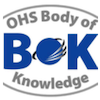Chapter 2: Introduction
Abstract
A defined body of knowledge is required as a basis for professional certification and for accreditation of education programs giving entry to a profession. The lack of such a body of knowledge for OHS professionals was identified in reviews of OHS legislation and OHS education in Australia. After a 2009 scoping study, WorkSafe Victoria provided funding to support a national project to develop and implement a core body of knowledge for generalist OHS professionals. The technical aspects of the project were managed by a technical panel with representation from universities and the professional body. An analysis and consultation process was used to develop a conceptual framework. Specialist authors were invited to contribute specific chapters, which then were subjected to peer review and editing. The outcome provides a basis for accreditation of OHS professional education programs and certification of OHS professionals. It provides guidance for OHS educators in course development, and for OHS professionals and professional bodies in developing continuing professional development activities. Also, OHS regulators, employers and recruiters will find it useful for benchmarking OHS professional practice. The OHS Body of Knowledge continues to be updated and further developed as people use and interpret it and as the evidence base expands.
Keywords: OHS, safety, body of knowledge, professional, certification, accreditation
First Year of Publication: 2012
Current Version: 2019
Chapter 2: Introduction
Table of contents
| 1 | Background to the OHS Body of Knowledge |
| 1.1 | Why the project was necessary |
| 1.2 | Scope of the project and some definitions |
| 1.3 | Principles underpinning development of the OHS Body of Knowledge |
| 2 | Development process (Edition 1) |
| 2.1 | Conceptual framework |
| 2.2 | Consultation |
| 2.3 | Writing |
| 2.4 | Review |
| 3 | Development from 2012 to 2018 |
| 3.1 | Responsibility |
| 3.2 | Development models |
| 4 | Development of Edition 2 (2019) |
| 5 | OHS Body of Knowledge and research |
| 6 | Outline of the OHS Body of Knowledge |
| 7 | Applications of the OHS Body of Knowledge |
| 7.1 | As a basis for accreditation of OHS professional education programs |
| 7.2 | As a basis for professional certification |
| 7.3 | To inform OHS professional education programs |
| 7.4 | To inform continuing professional development |
| 7.5 | Use by other groups |
| 7.6 | International influence |
| 8 | Dissemination |
| 9 | Future directions |
| 10 | Summary |
References

Pam Pryor AO, BSc, BEd, GDipOHM, MAppSci, ChOHSP, FSIA
Manager OHS Body of Knowledge Development, Safety Institute of Australia
Email: manager@ohsbok.org.au
With a background in OHS consulting and OHS education Pam now specialises in activities around OHS capability and related aspects of OHS professionality. She was the chair of the Technical Panel that developed the OHS Body of Knowledge and inaugural Registrar of the Australian OHS Education Accreditation Board. Her current role as Manager OHS Body of Knowledge Development focuses on the ongoing maintenance and further development of the OHS Body of Knowledge and associated resources. Pam is also involved in an international research network on OHS capability and was a key player in the development of the INSHPO Global OHS Capability Framework. Pam received an Officer of the Order of Australia in 2018 for her contribution to OHS through leadership and advisory roles, particularly in developing standards for education frameworks. Pam also received the 2017-18 President’s Award from American Society of Safety Professionals (ASSP) for her work on developing the Global OHS Capability Framework
No learning outcomes have been developed for the chapters considered introductory or underpinning knowledge (that is chapters 2, 3, 4, 5, 6, 7, 8, 14, 15.)

